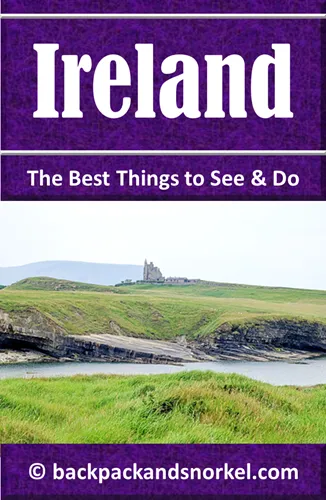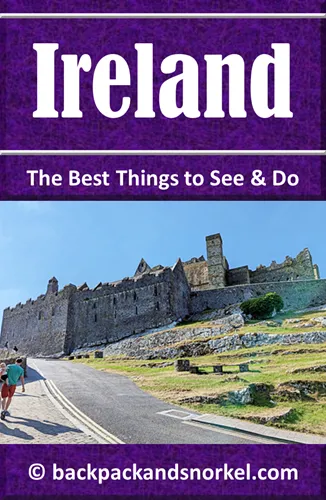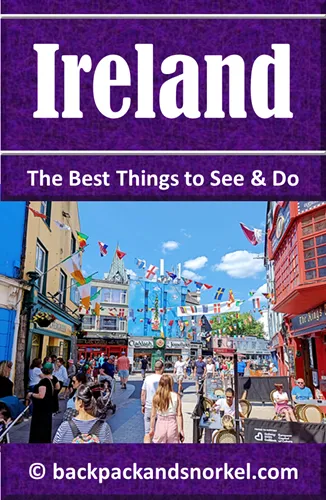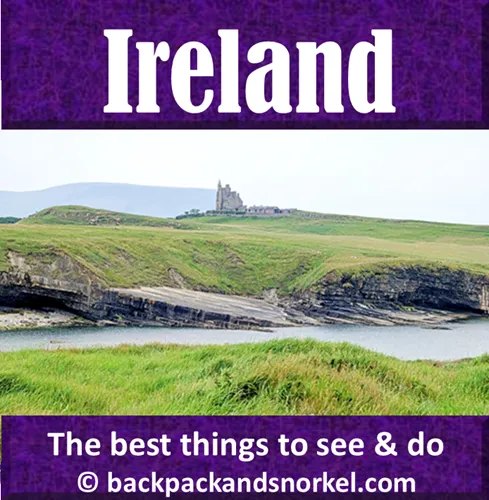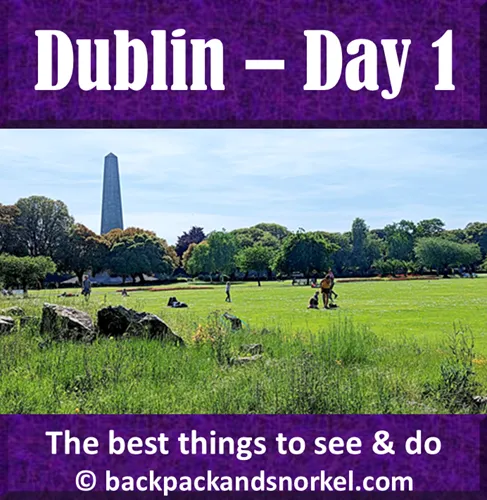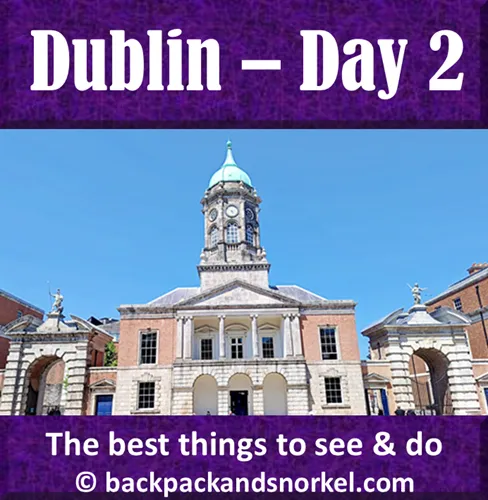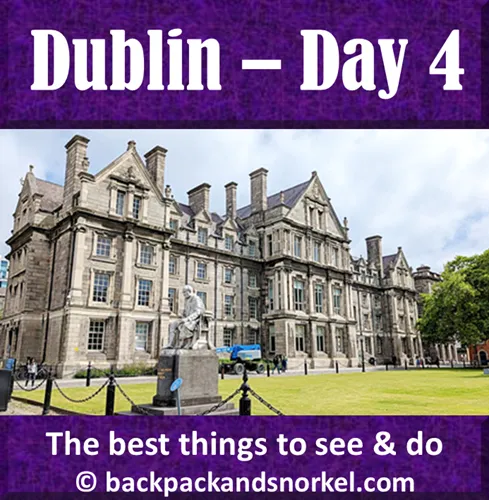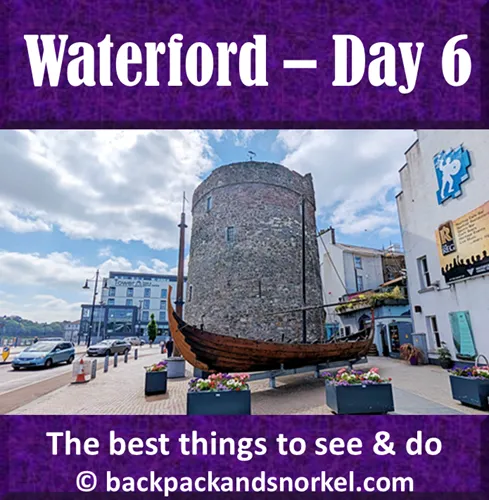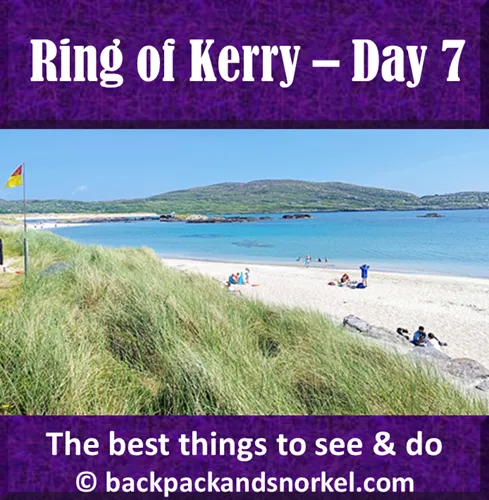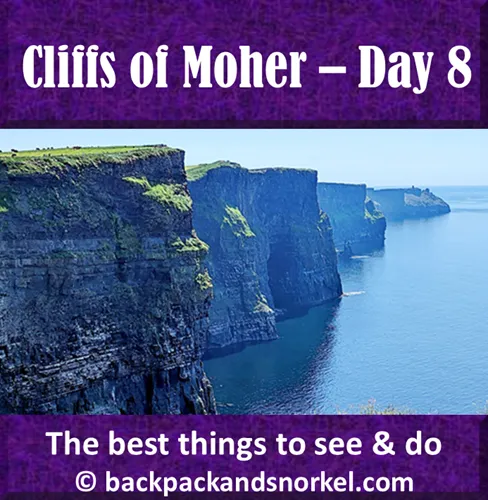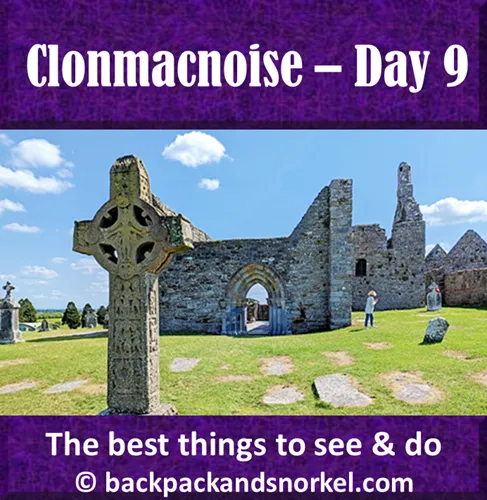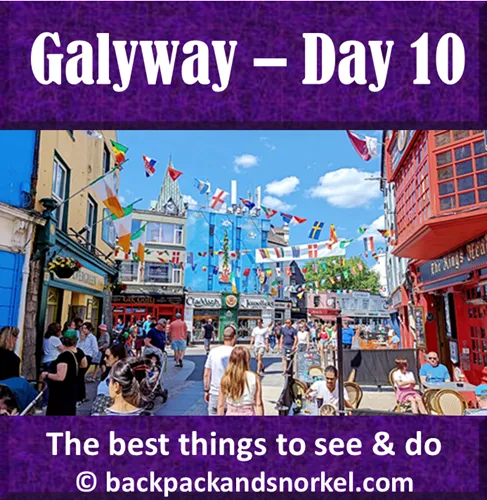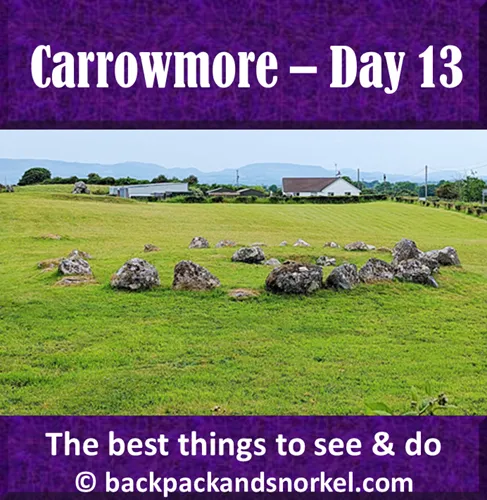Backpack and Snorkel Travel Guide for Clonmacnoise, Athlone, and Galway - Ireland Purple Travel Guide
Today we will see Clonmacnoise, Athlone, and the Galway Salthill Prom. We provide detailed information and the best things to see and we show lots of photos so you know what you can expect.
Today will be a slower day with less driving and more sightseeing.
From Galway we drive to the ruined and beautifully preserved monastery Clonmacnoise and afterwards, we will take a self-guided walking tour of the historical town of Athlone, which lies near the geographical center of Ireland.
We will finish the day at the Salthill Prom in Galway overlooking Galway Bay.

1 = Galway
2 = Clonmacnoise
3 = Athlone
4 = Galway Salthill Prom
Table of contents
Clonmacnoise
Clonmacnoise, meaning 'Meadow of the Sons of Nós’, was a monastery on the banks of the River Shannon. It is in ruins today, but well preserved and researched, and it even has a museum on site. For us, Clonmacnoise is the monastery that is most worthwhile visiting in Ireland.
In 544AD, Saint Ciarán, one of the Twelve Apostles of Ireland, and 7 followers arrived at the location where Clonmacnoise now stands. Together with Diarmait mac Cerbaill, who would later become Ireland’s first Christian High King, they built a wooden church.
The location was chosen a major east–west trade route crossed the River Shannon here at that time.
The strategic location helped Clonmacnoise become a very important center of religion and studies, as well as craftsmanship and trade by the 9th century and it even attracted scholars from the European mainland.
Its prominent location also meant that it was frequently attacked between the 8th and 12th century; at least:
- 27 times by the Irish
- 7 times by the Vikings
- 6 times by the Normans
From the 9th to the 11th century, the wooden buildings were replaced by stone buildings and the population grew from less than 10 clergy men to almost 2,000 people, including villagers that lived around the monastery.
During that time, the monastery was allied with the kings of Meath and many of those kings were buried here.
Starting in the 12th century, Clonmacnoise began to decline. The main reason was that a bridge in the nearby town of Athlone made crossing the River Shannon much easier and thus became much more popular than crossing at Clonmacnoise. Also, Athlone had the strongest defenses in the region, and made traveling much safer.
This led to a strong growth of Athlone and to a strong decline in traffic at Clonmacnoise. The constant attacks on Clonmacnoise only hastened its decline, and by the 13th century the monastery was mostly abandoned.
The most notable buildings and high crosses in Clonmacnoise are:

- Visitor Center museum (west of the site, not shown on the map): The original Cross of the Scriptures, North Cross and South Cross from the monastic site were moved into the museum to protect them from weathering and preserve them. Replicas of the three high crosses were installed in their original locations. The museum also has several tombstones and explains the engravings
- Temple Ciarán: With its leaning walls and sloping arched doorway this is probably the least spectacular building and smallest church on site (9 ft (2.8 m) x by 15.5 ft (3.8 m)). But looks can be deceiving, as it is one of the most important buildings in Clonmacnoise, as it was Saint Ciarán’s living quarters and it is said that he was buried here
- O'Rourke's Tower: This is the landmark of Clonmacnoise that is visible from miles away. The tower was built in 1124, and named after 10th-century Connacht king Fergal O'Rourke. A lightning strike in 1135 severely damaged the top, which had to be rebuilt
- Cathedral (Temple McDermot): This temple is the largest church in Clonmacnoise and it dominates the monastic site. Construction of the cathedral started around 909 AD. The Gothic-style north doorway is from the mid-15th century and it is often called the Whispering Arch - a confessional on the exterior of the Cathedral where you can confess your secrets.
the last High King of Ireland, Rory O'Connor, was buried near the altar in 1198. Most of the other graves in the church are members of the Coghlan family, who rebuilt the cathedral in the mid-17th century - Cross of the Scriptures: This sandstone cross is 13 ft (4m) tall and one of the most skillfully made crosses in Ireland. The greatest clue to the origin of the Cross of the Scriptures lies in the inscription carved at its base. Although badly weathered, enough remains to identify two names, Colman, Abbot of Clonmacnoise (c. 904-921) and the High King of Ireland, Flann Sinna.
It is known from the Annals of Clonmacnoise that they had collaborated in erecting a large stone Church (probably the Cathedral) in the early years of the 10th century. It seems likely that the cross was another collaboration between Flann and Colman, probably at a slightly later date.
Whatever its origins and significance, the massive cross of the Scriptures represents a highpoint of the stonecutters and carvers craft in Ireland. Perfectly proportioned, every detail of the cross is set within a standard mathematical composition, which corresponds logically with its overall construction.
The cross is rivalled in complexity and sophistication only by the contemporary crosses of Kells, Durrow, and Monasterboice, all of which also compare stylistically with the cross of the Scriptures and may have been carved by the same sculptor or school Of sculptors - North Cross: Created at around 800 AD, this is the oldest of the three high crosses. Only the limestone shaft on its sandstone base, which was a former millstone, have survived. On the east face of the shaft is a non-Christian decoration showing Cernunnos, the Celtic God of hunting and fertility
- South Cross: Created in the 9th century, this high cross shows an image of the Crucifixion of Christ on its west face
Clonmacnoise is open year-round, except December 24-26.
At the time of writing, the opening hours were:
November 1 – January 31: Daily 10am – 5pm
February 1 – March 12: Daily 10am – 5:30pm
March 13 – May 31: Daily 10am – 6pm
June 1 – August 31: Daily 9am – 6:30pm
September 1 – October 31: Daily 10am – 6pm




Athlone
The name Athlone comes from the Irish name: Baile Átha Luain, meaning ‘The town of Luan's ford’ – a ford is a shallow place in a river with good footing which can be crossed by wading, or inside a vehicle.
The town grew around Athlone Castle, which is strategically built in 1129 at the first location north of Clonmacnoise where River Shannon was passable.
That location, a bridge that was built over River Shannon in the 12th century, and the protection that Athlone Castle provided against constant raids were the keys to Athlone’s success, and Clonmacnoise’s downfall.
Over the centuries, Athlone has successfully defended the strategically important bridge over the River Shannon in multiple attacks and wars.
In our self-guided tour of Athlone, we will explore several historic sites.
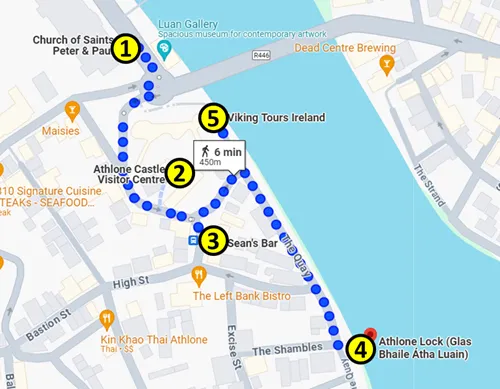
1 = Church of Saints Peter & Paul
2 = Athlone Castle
3 = Sean's Bar
4 = Athlone Lock
5 = Viking Tours
Church of Saints Peter & Paul
Start your tour at the Church of Saints Peter and Paul, which is a Roman Catholic parish church that was built from 1932 -1939.
The stained-glass windows were produced in the workshop of Irish stained-glass artist Harry Clarke.

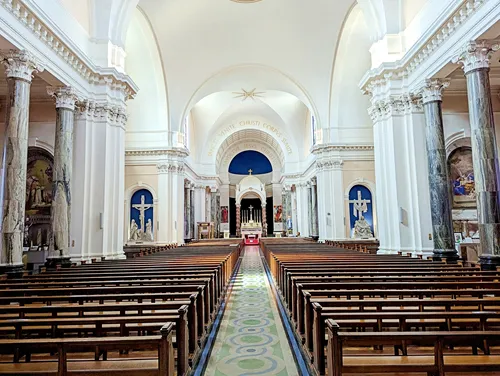

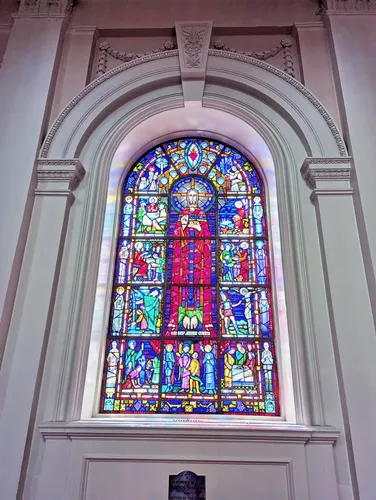
Athlone Castle
Across the street lies Athlone Castle. The earliest recorded castle in Athlone was a wooden timber castle that was built in 1129 together with a bridge that crossed the River Shannon.
A lightning strike in 1131 destroyed parts of the castle.
The first stone castle was built during Anglo-Norman times in 1210, bit its main tower collapses in 1211, because it was built on a manmade hill that was unable to take the weight of the structure.
Over the centuries, it was heavily modified, expanded and rebuilt, and it may have originally had a moat.
A new stone bridge was built in 1567 – it will last for almost 300 years.
In 1691, the castle is badly damaged by Williamite artillery during the course of the great siege of Athlone – after more than 500 years, the town and castle fall to attackers.
In 1697, much of the west town is destroyed when lightning causes the powder magazine in the castle to explode.
Throughout the 18th century the castle is in a dilapidated condition, and used as an accommodation annex to the nearby army barracks that were built around 1700.
The castle that you see today is mostly the result of fortifications made in 1804 during the Napoleonic era.
A new bridge across the River Shannon is built from 1841 – 1844 – it replaces the bridge from 1567.
Since 1967, the castle has been a National Monument and used as a museum, after almost 300 years of use as barracks.
After three years of renovation and restorative work, the castle reopens to the public in 2012.
The castle is closed every Monday, and also on Tuesdays from November through February.
At the time of writing, admission is Euro 12 per adult, but discounts are available for children and families.
Exhibits in the castle tell the story of Athlone from the early settlements through the sieges and warfare until modern times. And, you can explore the courtyard.
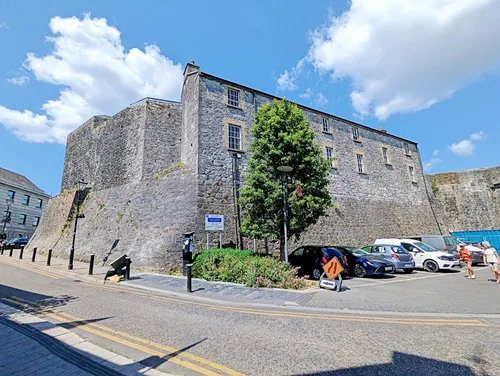

Sean's Bar
Guiness World Records have certified Sean’s Bar as the oldest pub in Ireland, operating since around 900 AD. The pub owners even claim to have a list of nearly all previous owners.
They also say that there is an ongoing investigations to probe if Sean’s Bar is the oldest pub in the world. There is no word on when the result will be available.
The building that Sean’s Bar is located in is mostly from the 17th or 18th century.
Renovations in 1970, however, found old coins and that the back wall was partly made of wattle and wicker that could date back to the 9th century. The coins are now on display in the National Museum of Ireland.


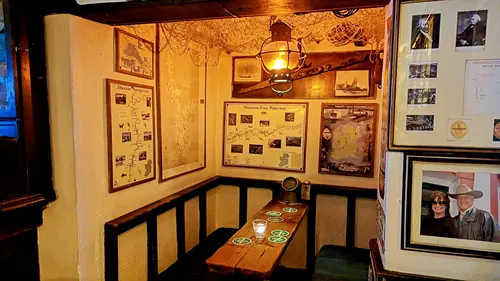
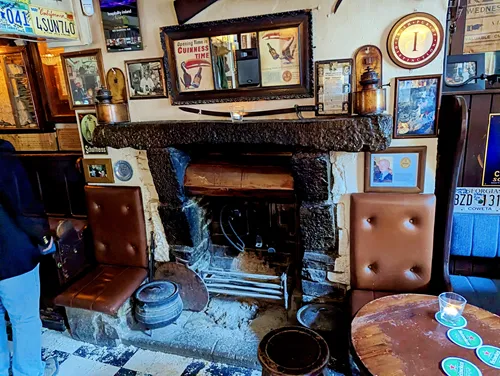

Athlone Lock
After you have had a drink or some food at Sean’s Bar, walk south along the River Shannon on The Quay street. You can stop by Athlone Lock to see boats on their journey through the lock up and down the river, or you can walk further south out of town.

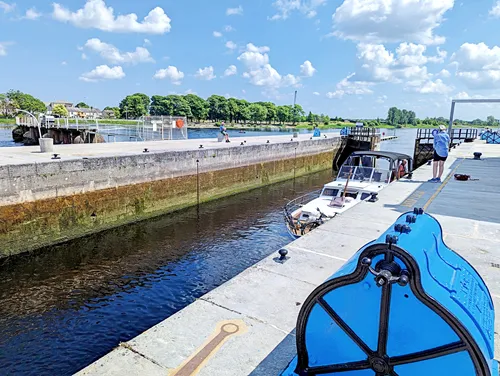
Viking Tours
Viking Tours depart from the dock near the Athlone Castle in replica Viking ships.
They offer daily Lough Ree Cruises and a cruise to Clonmacnoise from April through October on 1 to 5 days per week, depending on the month.
At the time of writing, Lough Ree Cruises cost Euro 20 per adult and Clonmacnoise cruises cost Euro 30 per adult.

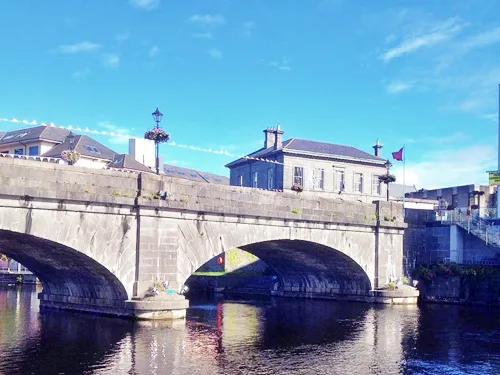
Galway Salthill Prom & Famine Ship Memorial
Salthill Prom(enade) is a 1.25-mile (2 km) promenade overlooking Galway Bay. It is a year-round tourist attraction.
Along the Prom are lots of beaches and lots of restaurants and, with Curry's Fun Park, even a theme park. Nearby Leisureland has an indoor swimming pool, a mini golf course and is a concert venue.
There are also Galway Atlantaquaria, an aquarium, and Seapoint Leisure, a casino, Omniplex Cinema Galway, and other venues.
Tourists discovered Salthill in the early 19th century when bathing became fashionable. From the 1880s visitors and day-trippers from Galway traveled on the cheap, horse-drawn trams to enjoy the sea air. The highlight of the trip was a stroll along the promenade. The tradition was to kick the wall' to show that you had completed the walk - the wall at the end of the walk located next to the Blackrock diving board.
The Galway Famine Ship Memorial was unveiled in 2012. The original monument commemorates 6-year-old Celia Griffin who died on the streets of Galway. It was expanded by two sandstone ships' sails on either side.
Each sail is engraved with the names of 50 ships which carried the people that tried to escape the Great Famine from 1845 - 1852. These ships were often called coffin ships, as diseases often spread like wildfire on them due to poor living conditions, killing many emigrants during their voyages.
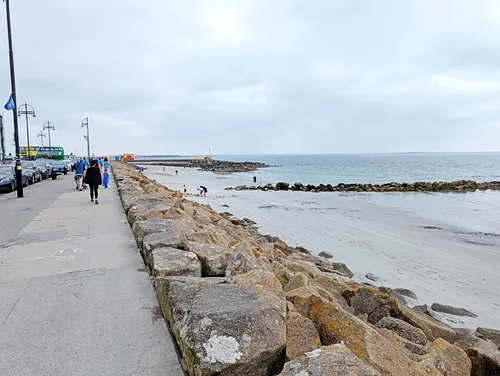
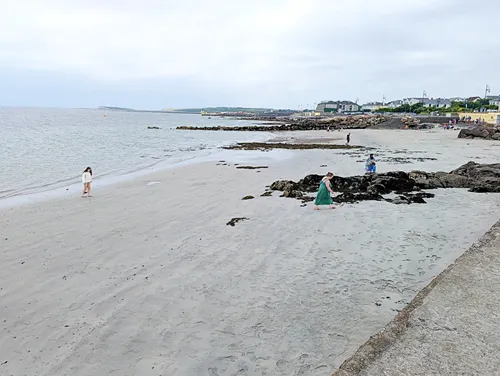

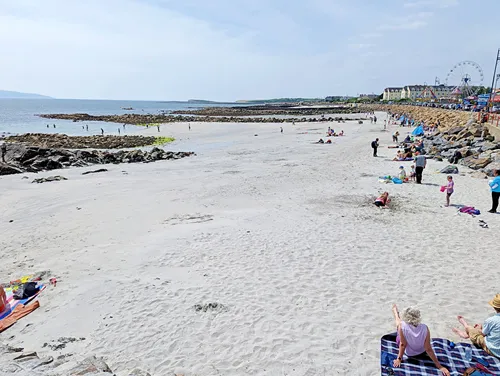

Where do you want to go now?
Other popular Purple Travel Guides you may be interested in:
Like this Backpack and Snorkel Purple Travel Guide? Pin these for later:
